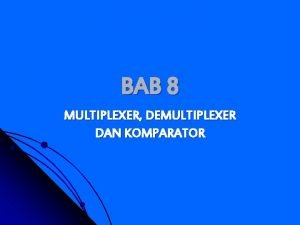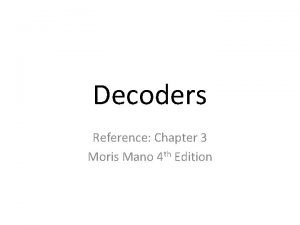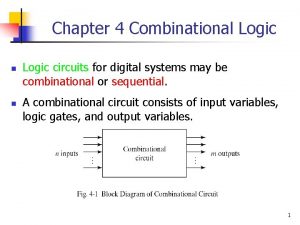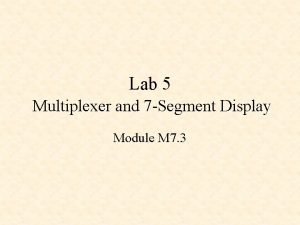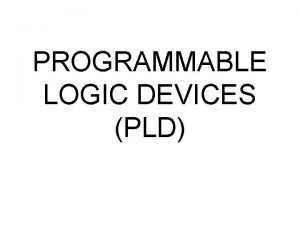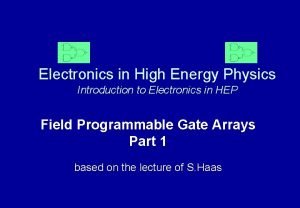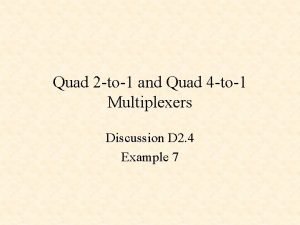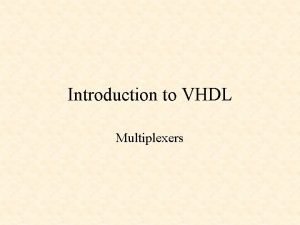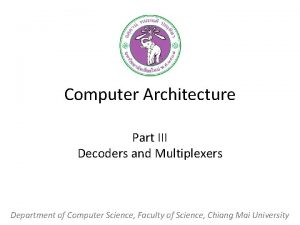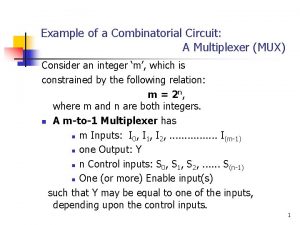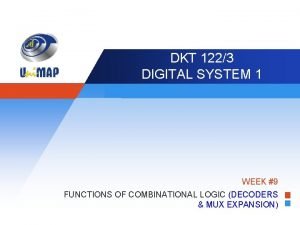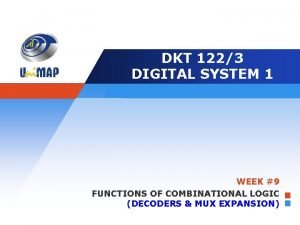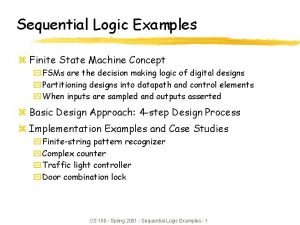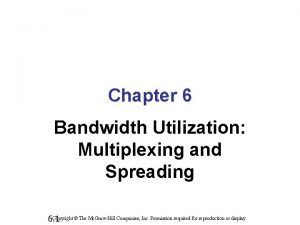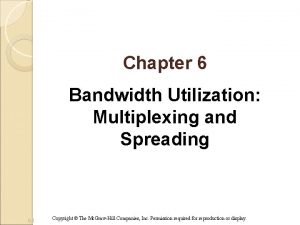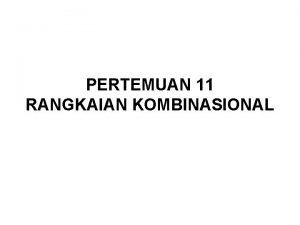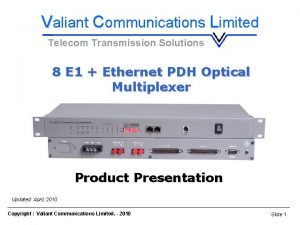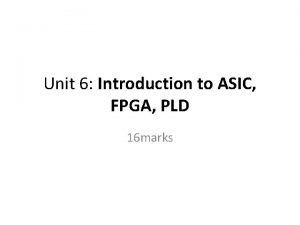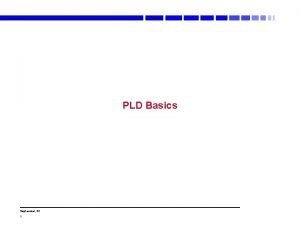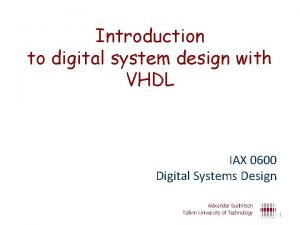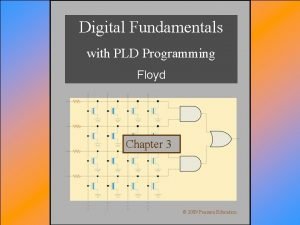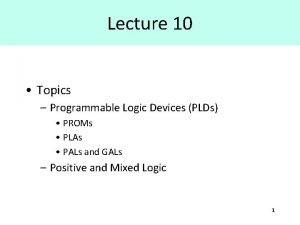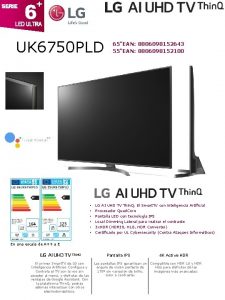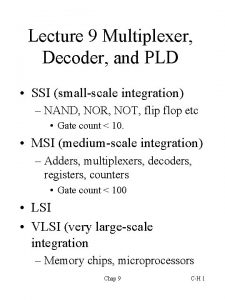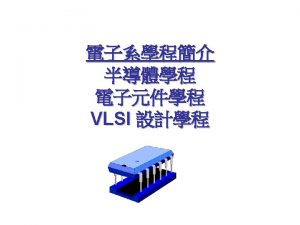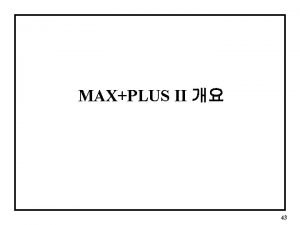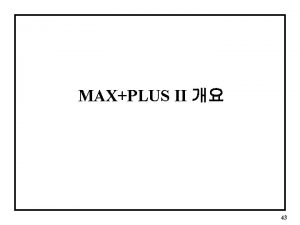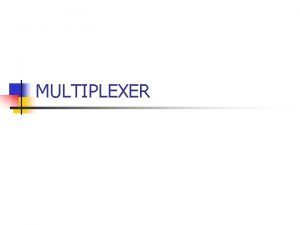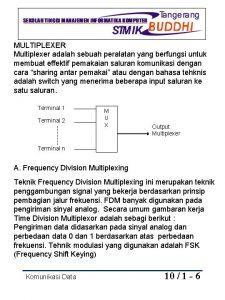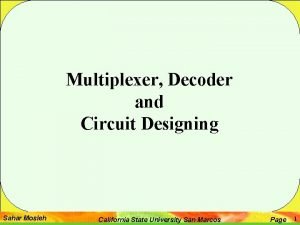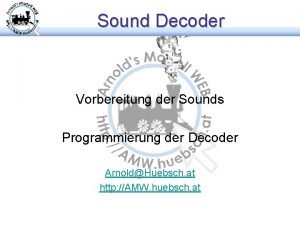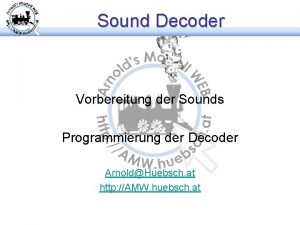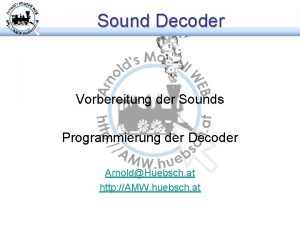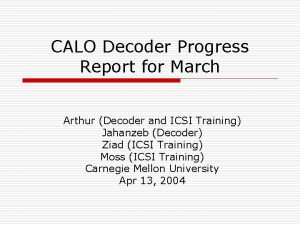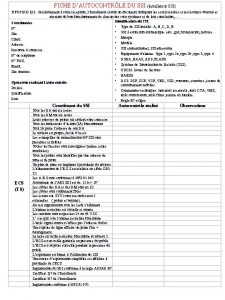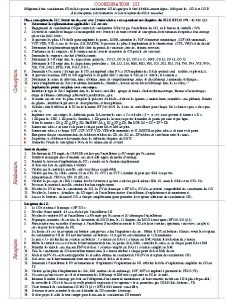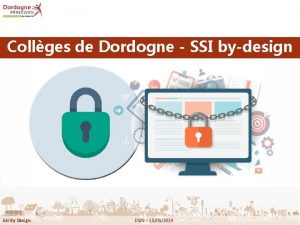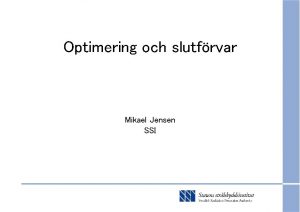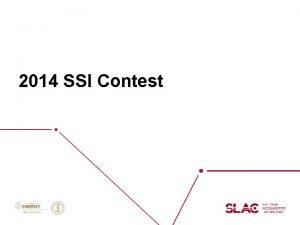Lecture 9 Multiplexer Decoder and PLD SSI smallscale




































- Slides: 36

Lecture 9 Multiplexer, Decoder, and PLD • SSI (small-scale integration) – NAND, NOR, NOT, flip flop etc • Gate count < 10. • MSI (medium-scale integration) – Adders, multiplexers, decoders, registers, counters • Gate count < 100 • LSI • VLSI (very large-scale integration – Memory chips, microprocessors Chap 9 C-H 1

Multiplexers • Multiplexers are selectors. Z = A’B’I 0 + A’BI 1 + AB’I 2 + ABI 3. (4 -to -1 MUX) Chap 9 C-H 2

Logic Diagram for MUX • 8 -to-1 MUX Chap 9 C-H 3

Application of MUX • Select data. Chap 9 C-H 4

Application of MUX Crossbar switch • As s=0, x 1 to y 1, x 2 to y 2. • As s=1, x 1 to y 2, x 2 to y 1. s x 1 y 1 x 2 y 2 (a) A 2 x 2 crossbar switch x 1 0 y 1 1 s x 2 0 y 2 1 (b) Implementation using multiplexers C-H 5

Using Mux for logic function, XOR • f = w 1 xor w 2 w 1 w 2 w f w 2 1 0 0 1 1 1 0 0 0 1 Chap 9 f C-H 6

Better • Modify the truth table. • When w 1 = 0, f = w 2. Otherwise, f = ~w 2 w 1 w 2 f 0 0 0 1 1 1 0 0 w f 1 w 0 w 1 2 2 w 1 w 2 f C-H 7

Using Mux to Implement a barrel shifter 2301 Chap 9 1230 C-H 8

Buffers/Tri-state Buffer • Driving capability • High impedance Chap 9 C-H 9

Tri-state Buffer Application • Data transfer between registers Chap 9 C-H 10

Tri-state Buffer Application (cont. ) • Source selection Chap 9 C-H 11

Decoder • 3 -to-8 line decoder – An n-to-2 n decoder generates all 2 n minterms of the n input variables. Chap 9 C-H 12

More Decoder • 2 -to-4 decoder: minterm generator Chap 9 C-H 13

Decoder (cont. ) • 4 -to-10 line decoder Chap 9 C-H 14

ROM • Read-only memory: stored data can not be changed under normal operating conditions. Chap 9 C-H 15

ROM (cont. ) • ROM size = 2 n x m bits. Chap 9 C-H 16

ROM Basic Structure • 8 -word x 4 bit ROM – F 0 = m 0 + m 1 + m 4 +m 6 Chap 9 C-H 17

Multiple-Output Network Using ROM • BCD to Excess-3 code Chap 9 C-H 18

Types of ROM • Mask-programmable ROM – Contents are stored during fabrication. • Field-programmable ROM – PROM: programmable ROM • Fusible link (PROM programmer) – EPROM: erasable PROM • Use ultraviolet light for erasure. – EEPROM: electrically erasable PROM. • Flash memory Chap 9 C-H 19

Programmable Logic Devices • PLA (programmable logic array) – Realize m functions of n variables. Chap 9 C-H 20

Implementation procedure for PLA • Prepare the truth table based on your system • Write the Boolean expression in SOP (sum of product) form. • Obtain the minimum SOP form to reduce the number of product terms to a minimum. • Decide the input connection of the AND matrix for generating the required product term. • Then decide the input connections of OR matrix to generate the sum terms. • Decide the connections of invert matrix. • Program the PLA. Chap 9 C-H 21

Programmable Symbology Chap 9 C-H 22

PLA • PLA 3 inputs, 5 product terms, 4 outputs. Chap 9 C-H 23

PLA • PLA circuit Chap 9 C-H 24

PLA (cont. ) • PLA 3 inputs, 5 product terms, 4 outputs. AND-OR array. Chap 9 C-H 25

PLA Application • f 1 = a’bd + ab’c’ + b’c • f 2 = c + a’bd • f 3 = bc + ab’c’ + abd • If abcd = 0111, 1 st, 5 th, 6 th rows are selected. f 1 = 1 +0+0, f 2 = 1+1+0, etc. Chap 9 C-H 26

Programmable Array Logic (PAL) • AND array is programmable. OR array is fixed. • Use input buffer to drive many ANDs. Input buffer Chap 9 C-H 27

Programmable Array Logic (PAL) • Full Adder using a PAL Chap 9 C-H 28

Why prefers PLA rather than ROM • A combinational circuit may occasionally have don't-care conditions. When implemented with a ROM, a don't care condition becomes an address input that will never occur. • The words at the don't care address need not be programmed and may be left in their original state(all 0's or all 1's ). • The has the result that all the bit patterns available in ROM are used, but for the don’t care addresses you really can do without them. Chap 9 C-H 29

What Programmable Means • "programmable" does not indicate that all PLAs are field-programmable. • Many are mask-programmed during manufacture in the same manner as a mask ROM. – This is particularly true of PLAs that are embedded in more complex and numerous integrated circuits such as microprocessors. • PLAs that can be programmed after manufacture are called FPGA (Fieldprogrammable gate array) Chap 9 C-H 30

Complex Programming Logic Devices • Xilinx XCR 3064 XL CPLD – Function block (16 macrocells)= PLA – Macrocell = a flip flop + multiplexers – IA routes signals Input of function block Chap 9 C-H 31

Function Block and MC • Signal from PLA -> marcocell -> I/O pin • Use CAD tool to fit the design into the PLD. Chap 9 C-H 32

Field Programmable Gate Arrays (FPGA) • Logic cell: configurable logic blocks (CLBs) • Input/Output blocks (I/O blocks) Chap 9 C-H 33

Configurable Logic Block • Inside a CLB: function generators (LUT), FFs, and MUXs • LUT: lookup table (truth table) is a reprogrammable ROM (16 1 -bit words) Chap 9 C-H 34

A Lookup Table (LUT) • If we want F = abc (one minterm) – 1110 (and F=1) + 1111 (and F=1) • Or if we want F = a’b’c’d’ + a’b’cd’ + …abcd. (15 minterms) • Require a single function generator. Program the LUT table to get what we want. To be implemented a b c d F 0 0 0 0 1 1 0 0 1 …. . 1 1 1 This is a 4 -variable function generator. Bit stored in the LUT. Chap 9 C-H 35

Shannon’s Expansion Theorem • What if # of variables > 4 variables f (x 1, x 2, … xn) = xi’ f (x 1, x 2, . . xi-1, 0, xi+1, … xn) + xi f (x 1, x 2, . . xi-1, 1, xi+1, … xn) = xi’ f 0 + xif 1 f (a, b, c, d, e) = a’ f(0, b, c, d, e) + a f(1, b, c, d, e) Let a = 0, what lefts are terms with b, c, d, e 2 -1 MUX F = a’I 1 + a I 2 Chap 9 C-H 36
 Multiplexer mempunyai input sebanyak…?
Multiplexer mempunyai input sebanyak…? 6 to 64 decoder using 4 to 16
6 to 64 decoder using 4 to 16 4 to 16 decoder using 3 to 8 decoder
4 to 16 decoder using 3 to 8 decoder Fixed and and fixed or is part of which pld
Fixed and and fixed or is part of which pld 01:640:244 lecture notes - lecture 15: plat, idah, farad
01:640:244 lecture notes - lecture 15: plat, idah, farad Multiplexer and demultiplexer in digital electronics
Multiplexer and demultiplexer in digital electronics Multiplexer and demultiplexer experiment
Multiplexer and demultiplexer experiment What is plds
What is plds The cpld contains several pld blocks and
The cpld contains several pld blocks and 2to1mux
2to1mux Vhdl mux 8 to 1
Vhdl mux 8 to 1 What is decoder expansion in computer architecture
What is decoder expansion in computer architecture Multiplexer example problem
Multiplexer example problem Multiplexer means
Multiplexer means Mux 74157
Mux 74157 State diagram
State diagram Sdh layers
Sdh layers Bandwidth utilization multiplexing and spreading
Bandwidth utilization multiplexing and spreading What is multiplexer
What is multiplexer Dwdm multiplexer
Dwdm multiplexer Contoh soal multiplexer
Contoh soal multiplexer Encoder vs multiplexer
Encoder vs multiplexer Pdh multiplexer
Pdh multiplexer Pld vs fpga
Pld vs fpga Pld
Pld Pld pla
Pld pla Vivado
Vivado Pld programming
Pld programming Complex adalah
Complex adalah Prom, pla, pal and gal are considered like?
Prom, pla, pal and gal are considered like? Pld the shift
Pld the shift Lg 43 uk 6750 pld
Lg 43 uk 6750 pld Minterm generator
Minterm generator Lsi vlsi ulsi
Lsi vlsi ulsi Control unit
Control unit Pla and pal examples
Pla and pal examples Attention is all you need
Attention is all you need
